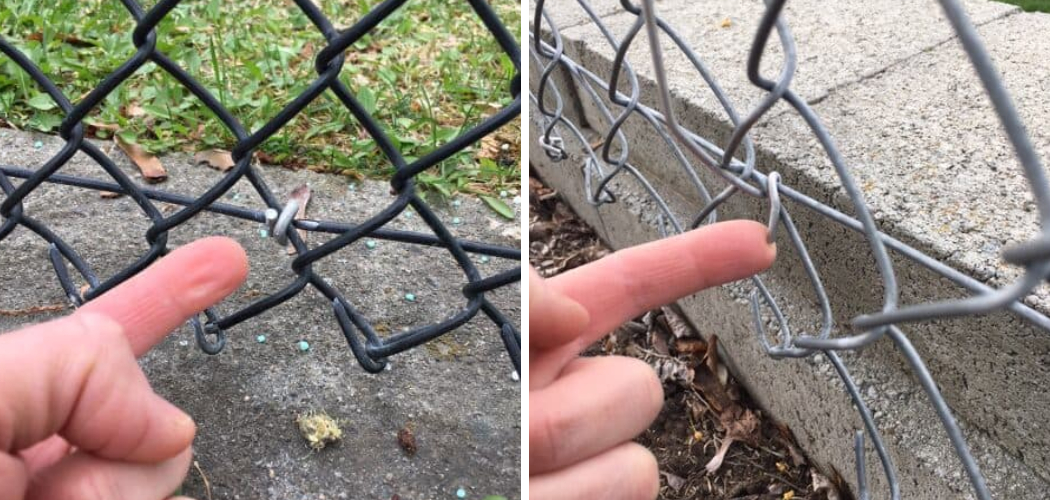Securing the bottom of a chain link fence is a critical measure to ensure the safety and integrity of a property’s perimeter. This essential task not only fortifies the fence against potential intruders but also plays a significant role in maintaining its aesthetic appeal and preventing animals from burrowing underneath.
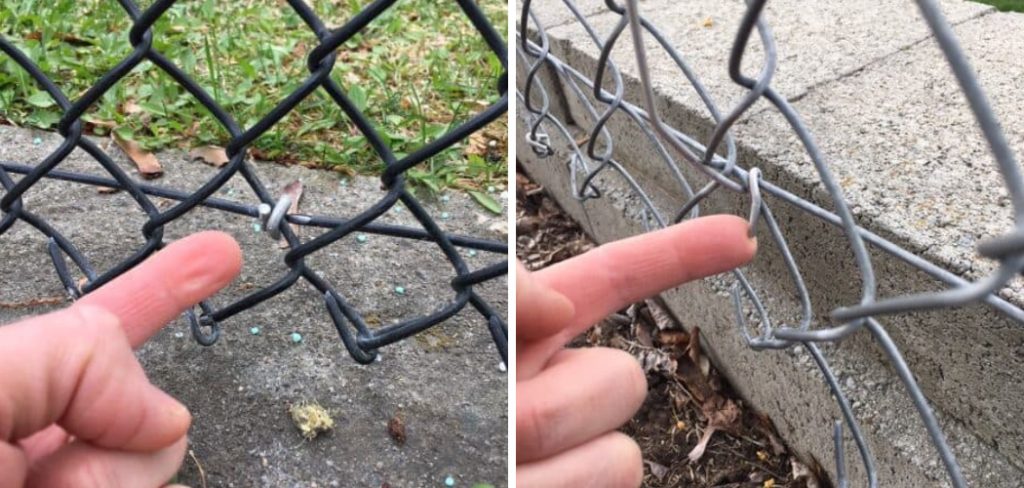
For homeowners and property managers alike, understanding how to secure the bottom of a chain link fence is pivotal in safeguarding their grounds against unwanted access and preserving the fence’s structure. Fortunately, there are several effective methods to achieve this, each catering to different needs and preferences.
These include installing a tension wire, adding a bottom rail, burying mesh beneath the fence line, or employing stake-on mesh solutions. Additionally, decorative enhancements like gravel or landscaping fabric can also serve the dual purpose of security and visual improvement. This guide aims to explore these options, providing a comprehensive overview that helps readers choose the most suitable method for enhancing the security and aesthetics of their chain link fences.
Understanding the Need for Bottom Security
A. Security Concerns
An unsecured bottom of a chain link fence significantly undermines the security of a property. It becomes a vulnerable point through which animals and potential intruders can easily gain access. For example, wildlife or stray animals may wander into the property, causing damage or potential harm.
More concerning, however, is the ease with which intruders can lift the unsecured fence to enter the premises. This risk highlights the critical importance of securing the bottom of the fence, thereby fortifying the property’s perimeter and ensuring its integrity against unauthorized access.
B. Preventing Animals from Digging Under
Securing the bottom of a chain link fence is crucial for property owners with pets or near wildlife habitats to prevent animals from digging under and escaping or intruding. Dogs and small pets, in particular, have a propensity for trying to dig their way under fences, posing a significant risk of getting lost or encountering danger outside the property boundary.
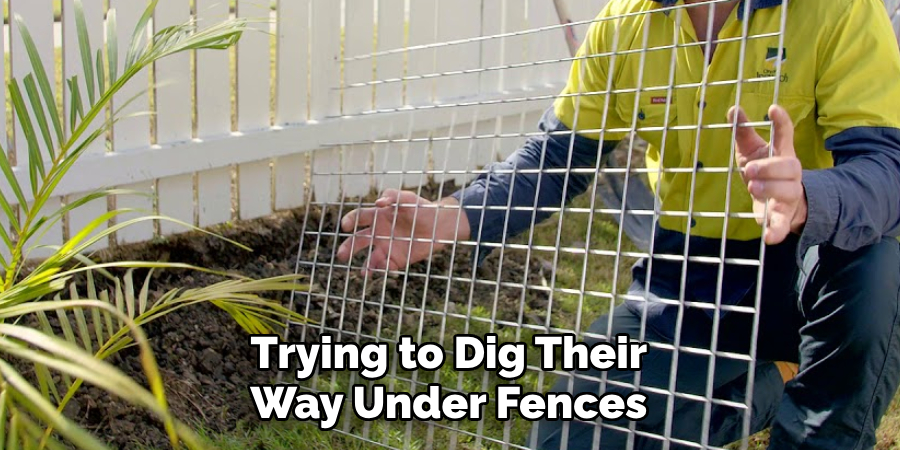
Similarly, wild animals digging under the fence can invade the property, potentially causing damage or threatening household pets. Properly securing the fence bottom can effectively mitigate these risks by creating a physical barrier that deters digging.
C. Maintaining a Finished Look
Additionally, a secured bottom contributes significantly to the clean and professional appearance of the fence. Besides serving as a functional security measure, it also prevents unsightly gaps and irregularities along the bottom edge, ensuring the fence looks well-maintained and cohesive. This aesthetic consideration is crucial for maintaining the property’s overall appeal and value.
Choosing the Right Method for Your Needs
A. Factors to Consider
When determining how to secure the bottom of a chain link fence, several factors come into play that will guide your decision. Budget is a primary consideration as the costs vary widely between the different methods available. The desired level of security is another crucial factor; stronger barriers may be necessary in areas prone to wildlife intrusion or unauthorized human access.
Existing soil conditions can affect the feasibility of certain methods, such as the installation of a buried mesh or stake-on options. Lastly, your fence’s height and overall design might influence your choice, particularly if aesthetic coherence is a priority.
B. Common Bottom Security Options
Tension Wire: Adding tension wire to the bottom of a chain link fence enhances its rigidity, making it more difficult for animals or intruders to push under it. This option is relatively inexpensive and straightforward to install. Galvanized steel, which offers durability and resistance to weather conditions, is a suitable material for the tension wire.

Bottom Rail: Installing a bottom rail adds significant strength to the fence, preventing it from being lifted or bent at the bottom. Material options for bottom rails include aluminum, which is lightweight yet sturdy, and galvanized steel for maximum durability. This option requires a bit more effort in installation, as it involves attaching the rail to the fence posts, but it provides a high level of security and stability.
Buried Mesh: For properties needing protection against digging animals, burying a mesh beneath the fence line is highly effective. This method entails digging a trench about 12 inches deep along the fence line and then securing a durable mesh material in the trench. It’s particularly suited for areas with persistent problems with wildlife or pets digging under the fence.
Stake-on Mesh: This cost-effective solution involves attaching mesh to stakes positioned along the fence line. It’s particularly suitable for temporary needs or for added security in specific areas rather than the entire perimeter. Stake-on mesh can be adapted to various ground conditions by selecting appropriate stakes, such as metal for harder soil or plastic for softer terrains.
Decorative Options: Adding gravel or landscaping fabric around the base of the fence not only improves security by deterring digging but also enhances the fence’s appearance. While not as secure as the other methods, these options can be a complementary measure, providing both aesthetic appeal and a certain level of protection against intrusion.
How to Secure the Bottom of A Chain Link Fence: Tension Wire
A. Materials Needed
To install a tension wire at the bottom of a chain link fence, you’ll need the following materials: galvanized tension wire designed for outdoor use, which provides durability and resistance against weather conditions; tensioners (also known as wire tighteners or tension bars), which are essential for pulling the wire tight; fence clamps for securing the wire to the chain link fabric; a come-along or T-bar for the tensioning process; wire cutters for cutting the wire to the desired length; and safety equipment, including gloves and eye protection, to prevent injuries during installation.

B. Step-by-Step Installation Guide
Measuring and Cutting Wire
Begin by measuring the length of your fence to determine the amount of tension wire needed. Add a few extra feet to your measurement to account for any adjustments during installation. Use wire cutters to cut the tension wire to your measured length. Before proceeding to the next step, ensure the wire is straight and free from kinks.
Attaching Wire to Terminal Posts
Secure one end of the tension wire to a terminal post (corner, end, or gate post) using a fence clamp. Loop the wire around the post and through the clamp, then tighten the clamp to hold the wire in place. Starting at a terminal post is important to ensure maximum stability and tension along the fence line.
Tensioning the Wire
With the wire attached to the starting terminal post, gradually unroll it along the bottom edge of the fence toward the next terminal post. Use a come-along or T-bar to apply tension to the wire.
Hook the come-along to the wire and the terminal post, then crank the handle to pull the wire taut. The goal is to eliminate any sagging or looseness but avoid over-tightening, as it could damage the wire or fence fabric.
Securing the Wire to Fence Fabric
Once the wire is sufficiently tensioned between the terminal posts, it’s time to secure it to the fence fabric. Use fence clamps at regular intervals along the fence line to fasten the tension wire to the bottom of the chain link fabric.
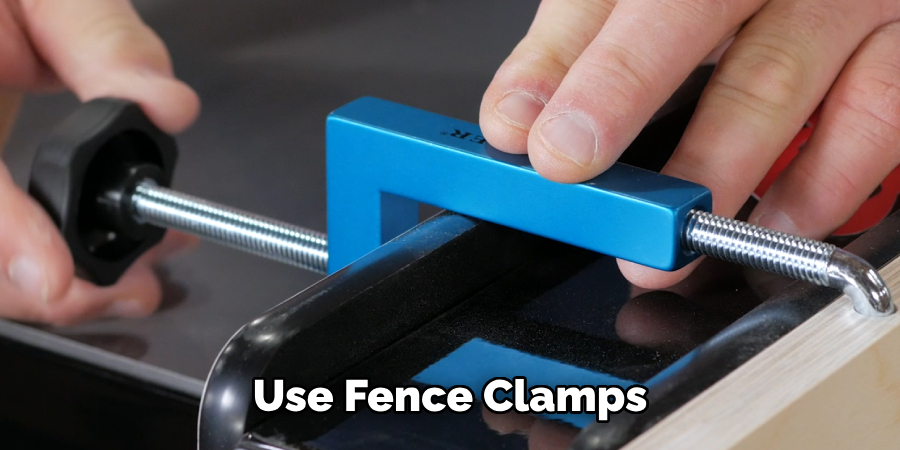
This step is crucial for enhancing the fence’s stability and preventing animals or intruders from pushing under it. After securing the wire to the fence fabric, cut any excess wire and make final adjustments to ensure the wire is evenly tensioned along the entire fence length.
By following these steps, homeowners and property managers can significantly strengthen the security of their chain-link fences, deterring potential intruders and preventing small animals from compromising the perimeter.
Additional Considerations for Tension Wire
Maintaining the proper tension level is crucial for the effective use of tension wire; it is too loose and fails to secure the bottom of the fence against intrusions, too tight, and it risks damaging the fence fabric or posts. Periodic checks and adjustments may be needed to keep the tension wire effective over time, especially after extreme weather conditions.
Additionally, while tension wire adds significant security, it can be somewhat visible, potentially affecting the aesthetic appeal of some property owners. Proper installation and regular maintenance can mitigate these concerns, ensuring the tension wire remains a valuable security feature.
How to Secure the Bottom of A Chain Link Fence: Bottom Rail
Adding a bottom rail to a fence not only enhances its stability and security but also contributes to its overall appearance. Choosing the right material for your bottom rail is crucial in achieving both function and form in your fencing project.
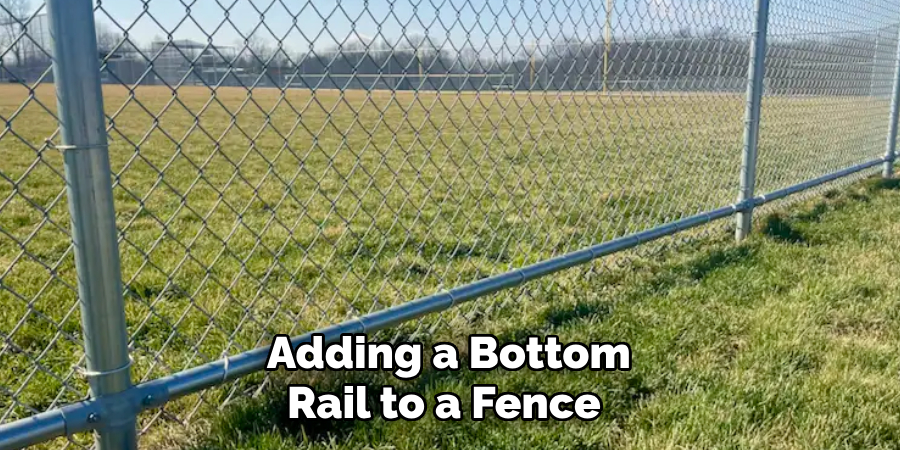
A. Choosing the Right Rail Material
When selecting a material for the bottom rail of a fence, three primary options stand out: galvanized steel, pressure-treated wood, and vinyl. Galvanized steel offers unparalleled durability and strength, making it suitable for security-oriented applications. Pressure-treated wood provides a natural look that can blend seamlessly with outdoor environments, offering a balance of durability and aesthetics.
Vinyl, on the other hand, promises minimal maintenance with its resistance to rust, decay, and insect damage, alongside its clean, modern appearance. The choice among these materials should align with the property’s specific needs, including considerations for durability, maintenance, aesthetics, and budget.
B. Materials and Tools
To install a bottom rail, you will need the appropriate rail material (galvanized steel, pressure-treated wood, or vinyl), brackets designed for your chosen rail, fasteners suitable for the rail material (such as screws for wood or bolts for steel and vinyl), a drill, a saw for cutting the rail to the desired length, and a level to ensure proper alignment. Additionally, protective gear, including gloves and safety glasses, is recommended to ensure a safe installation process.
C. Step-by-Step Installation Guide
- Cutting Rails to Size: Measure the length between fence posts to determine the length of your bottom rail. Use a saw to cut your selected rail material to these measurements, ensuring each piece fits snugly between the posts.
- Attaching Brackets to Fence Posts: Position brackets at the desired height on your fence posts, ensuring they are level. Use your drill and appropriate fasteners to secure the brackets in place. Depending on the material of your fence posts, pre-drilling holes may be necessary to ease this process and prevent damage.
- Securing Rails to Brackets: Slide the cut rails into the brackets mounted on each fence post. Check that the rail is level before securing it to the brackets with screws or bolts. This step is crucial for maintaining the structural integrity and appearance of the fence.
- Attaching Fence Fabric to the Bottom Rail (Optional): For additional security and stability, you can attach the bottom edge of the fence fabric directly to the rail. Use appropriate fasteners to secure the fabric, distributing them evenly along the rail to prevent sagging or gaps.
By carefully selecting your materials and following these installation steps, you can ensure that your bottom rail adds aesthetic appeal and functional stability to your fence, enhancing your property’s overall security and look.
How to Secure the Bottom of A Chain Link Fence: Buried Mesh
A. Safety Precautions
Before beginning any digging project, calling 811 to have underground utilities marked is essential. This simple step is not just a safety precaution; it’s a legal requirement in many areas. Identifying and avoiding these utilities prevents potential harm to yourself and the integrity of vital community services.
B. Digging the Trench
Digging a trench along the intended fence line is a critical step for installing buried mesh. The trench should be approximately 12 inches deep and 6 to 8 inches wide, providing sufficient space to bury the mesh below the surface. This depth helps prevent animals from digging under the fence while keeping the mesh concealed.
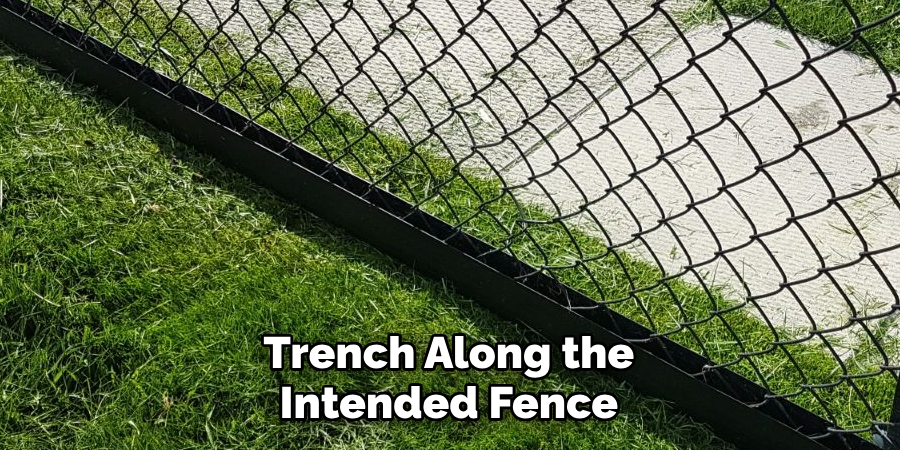
For larger projects, use a spade or a power trencher to create a clean, consistent trench. Remember to follow all safety guidelines for handling equipment and be mindful of the marked utilities.
C. Securing the Buried Mesh
Once the trench is dug, laying and securing the buried mesh is the next crucial step. The mesh should be laid flat at the bottom of the trench, extending upwards against the fence’s bottom edge. Consider using a metal edging or weed barrier along the trench to keep the mesh in place. This not only secures the mesh but also prevents weeds from growing through it.
Fill the trench carefully, ensuring the soil is compacted around the mesh for additional support. For added durability, you might anchor the mesh to the bottom of the fence with ties or staples, maintaining a seamless barrier against burrowing animals. Regular inspection and maintenance of the buried mesh will ensure it remains an effective deterrent over time.
Installation Techniques: Stake-on Mesh
A. Material Selection
When selecting stakes for attaching mesh to the ground, the soil’s condition must be considered. Metal stakes are highly recommended for harder or rocky soil, as their durability allows them to penetrate tough surfaces without bending. For softer, more pliable soils, plastic stakes provide sufficient stability and are easier to install, offering a cost-effective solution that doesn’t compromise performance.
B. Step-by-Step Installation Guide
- Positioning Stakes Along the Fence Line: Begin by marking the positions where the stakes will be placed along the perimeter of your fence. These should be evenly spaced to ensure uniform support for the mesh. For optimal stability, stakes should be placed at intervals of 5 to 6 feet.
- Driving Stakes into Ground: Using a rubber mallet or a hammer, drive the stakes into the ground at the marked positions. Ensure that each stake is embedded deeply enough to provide robust support, typically about 12 to 18 inches, depending on the stake’s length and the soil’s hardness.
- Attaching Mesh to Stakes: Roll out the mesh along the length of the fence line and cut it to size if necessary. Begin attaching the mesh to the stakes using zip ties, wire, or specialized mesh clips, starting from one end of the fence line. Pull the mesh taut to avoid any sagging and secure it at various points on each stake to distribute the tension evenly.
- Final Adjustments: Once the mesh is secured to all stakes, walk along the fence line to make any needed adjustments. Ensure the mesh is uniformly taut and securely attached to each stake. Trim any excess zip ties or wires for a clean finish. Regularly inspect the mesh and stakes to maintain the integrity of your barrier over time.
By following these steps, you’ll establish a sturdy, reliable boundary that leverages stake-on mesh installation techniques, effectively enhancing your property’s security and aesthetic appeal.
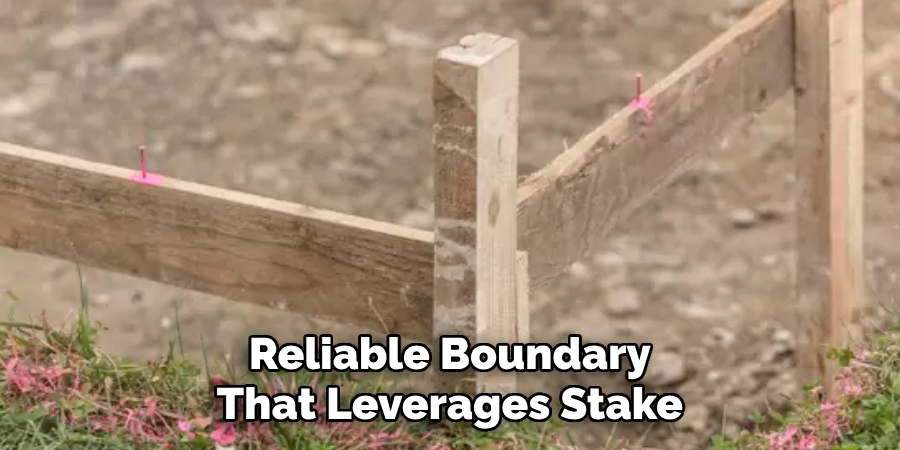
Finishing Touches and Maintenance
A. Filling Gaps with Gravel or Decorative Rock
To enhance your fence’s aesthetic appeal and functionality, consider adding a layer of gravel or decorative rock along the base. This strategy not only provides a polished and sophisticated finish to your property’s boundary but also acts as a deterrent to animals that might attempt to dig under the fence.
The weight and texture of the gravel or rocks make it difficult for critters to penetrate, adding an extra layer of security to your fence installation.
B. Landscaping with Plants
Using low-growing shrubs or flowering plants along the fence line can beautify your outdoor space. This landscaping approach augments your property’s visual appeal and contributes to a more inviting and vibrant environment, harmoniously blending the fence into your garden or yard.
C. Regular Maintenance Checks
To ensure the longevity and effectiveness of your fence, it’s critical to perform regular maintenance checks. Inspect the fence for any signs of wear or damage, such as loose wires, broken rails, or areas where the mesh might have become exposed. Promptly addressing these issues will help maintain your fence’s structural integrity and appearance, ensuring it continues to serve its purpose effectively.
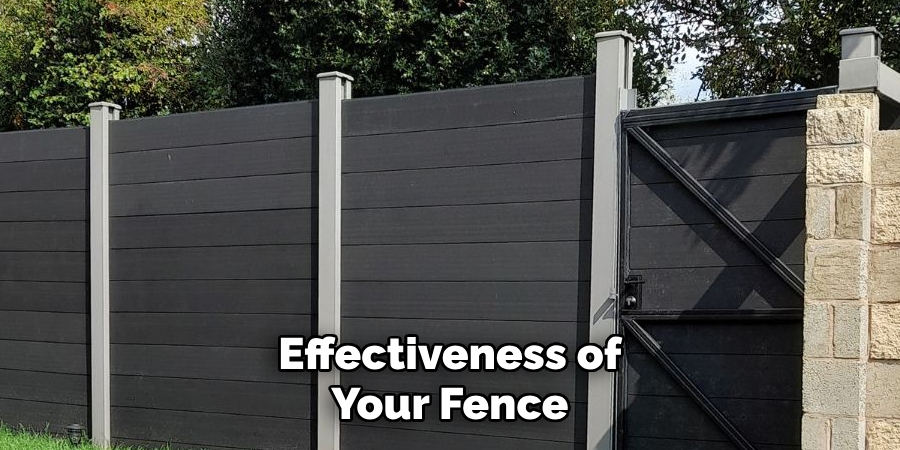
Conclusion
Securing the bottom of a chain-link fence is pivotal in ensuring comprehensive property protection while enhancing aesthetic appeal. This guide has explored various methods on how to secure the bottom of a chain link fence, each with unique advantages and considerations.
The buried mesh technique offers excellent deterrence against burrowing animals and is hidden from view, maintaining the fence’s clean line. However, significant digging effort and regular maintenance are required to ensure its effectiveness.
On the other hand, the stake-on mesh technique is less labor-intensive and provides flexible installation options suited for different soil types, though it might be more visible and require more frequent adjustments.
In deciding the best method to secure the bottom of your chain link fence, consider factors such as the local wildlife, soil type, aesthetic preferences, and your readiness to engage in maintenance activities. Regardless of the chosen method, ensuring a secure and intact fence bottom is crucial for deterring unwanted intrusions and maintaining a polished look for your property.
By following the steps outlined in this guide, homeowners can achieve a durable, visually pleasing, and secure fence setup that meets their specific needs and enhances their overall property security and appeal.

